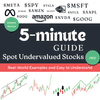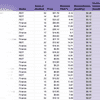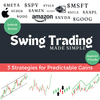
📊 Unlock Powerful Stock Charts!
Get real-time data, custom indicators, and in-depth stock analysis with TradingView.
Try TradingView FreeHow to Invest Your First $1,000 on Robinhood: A Beginner’s Guide (2024 Edition)
Sat, Nov 23, 2024
Table of Contents
So, you’ve decided to start investing. Good for you. If you’re anything like I was when I started, you probably feel overwhelmed, maybe a little intimidated, and definitely unsure of where to even begin. Let me simplify it for you.
I’ll walk you through exactly how I’d start with Robinhood if I were doing this all over again—no jargon, no fluff. Just practical steps you can take today.
What is Robinhood, and Why Do I Use It?
Robinhood is this beginner-friendly app that lets you invest in stocks, ETFs, and other assets without fees. It’s straightforward and great if you’re just starting out. Signing up is easy: download the app, fill in some basic info (your name, address, Social Security number, and bank details), and you’re ready to roll. You even get a free stock when you sign up. Sign up for Robinhood here and grab your free stock.
For those diving into the stock market, this approach works well for individual stocks too. If you’re curious about specific stocks like NVIDIA, check out my blog on Is NVIDIA ($NVDA) Stock Worth the Hype? Here’s What the Data Shows.
How I Decide What to Invest In
When I first started, I had no clue what to buy. So here’s my simplified approach: ETFs. Exchange-Traded Funds are basically bundles of stocks that let you invest in a lot of companies at once. They’re less risky than buying individual stocks, and they make life easier.
I stick to two types:
- Dividend ETFs like SPHD (pays you monthly just for holding them).
- Growth ETFs like VTI (focused on long-term growth).
It’s not about picking the next Amazon or Tesla—it’s about keeping it simple and steady. If you’re exploring other strategies, I’d also recommend looking at books that help shape an investor mindset. Here’s my list of 5 Books That Will Make You Rich: Investing for Beginners.
How to Set Up Automatic Investing
Consistency is key when investing. One of the first things I do is set up automatic deposits. I’d start with whatever amount feels doable—$100 a month is a solid number. This way, the money moves from your bank account to Robinhood automatically, and you don’t have to think about it. It’s like paying yourself first.
To set this up:
- Go to the Transfers section in the app.
- Select “Automatic Deposits.”
- Choose an amount and frequency.
- Boom, you’re done.
Want a different tool for investing? Try M1 Finance for fractional shares and automated investing.
Buying Your First ETF
Once the account is funded, it’s time to buy. This is where things get fun. Let’s say I’m buying SPHD. Here’s how I do it:
- Search for “SPHD” in the app.
- Tap “Buy,” but instead of using a market order (which buys at the current price), I’d use a limit order. Why? Because it gives me control over the price I pay.
- Set the limit price to something reasonable (e.g., $42.50).
- Confirm the order.
If the stock hits that price, the order goes through. If not, no harm done. The money stays put.
If you’re curious about what can go wrong with certain stocks or ETFs, take a look at my analysis of Biggest Stock Losers This Month November 2024: What Went Wrong?.
Why I Love ETFs
ETFs are the ultimate no-brainer for beginners. Imagine owning tiny pieces of hundreds of companies in one simple package. If one company tanks, the others balance it out. It’s like a built-in safety net.
Take SPHD, for example. It has a dividend yield of 4.3%. For every $100 invested, you’d earn $4.30 a year in dividends. On top of that, the ETF itself grows over time. It’s a win-win.
Want better stock tracking and analysis? Check out TradingView here for detailed charts and data.
What About Roth IRAs?
Once I got the hang of investing, I opened a Roth IRA. It’s a retirement account where your money grows tax-free. When you’re ready to retire, you can withdraw it without paying taxes—a huge deal.
I use M1 Finance for this because it’s easy to set up and automate. If you’re serious about long-term wealth, a Roth IRA is worth looking into.
For more insights on companies with strong fundamentals that could belong in your portfolio, check out my breakdown of Walmart $WMT Q3 Earnings Forecast: Key Strategies, Analyst Ratings, and Red Flags.
Is Robinhood Safe?
This is a fair question. Robinhood is SIPC-insured, which means your investments are protected up to $500,000 (and $250,000 for cash). That said, this doesn’t cover market losses—just if the brokerage itself goes under. Your investments can still lose value, so only put in what you can afford to lose.
The Big Takeaway
Investing doesn’t have to be complicated. Here’s what I’d do if I were starting today:
- Download Robinhood and claim your free stock here.
- Set up automatic deposits.
- Buy ETFs like SPHD or VTI.
- Stay consistent and let time do the work.
That’s it. No stock picking, no market timing, no stress. Just start small, keep it simple, and watch your money grow.
If you’re still reading, you’re already ahead of most people. So, what are you waiting for? Open the app, start with $10, $50, $100—whatever works for you—and take the first step toward building your future. You got this.
Not financial advice, just sharing my thoughts!
Related Posts
My Robinhood Trade: Why I Believe $HOOD is Headed to $150!
Wed, Jul 2, 2025
I'm betting on Robinhood ($HOOD) hitting $150! Discover my deep dive into its explosive growth, crypto dominance, and why I'm buying this fintech stock now.
Free Cash Flow Margin (FCF Margin) - Revenue Lies. Profit Misleads. This Tells the Truth.
Tue, Jun 10, 2025
Learn how free cash flow margin reveals a company’s real cash health beyond profit and why it matters for smarter investing decisions.
Free Cash Flow - This One Number Reveals What a Company Really Makes
Fri, Jun 6, 2025
Learn what free cash flow really means, how to calculate it, and why it matters more than revenue in stock analysis.
🌟 Buy Me Coffee
Love the market insights, stock analyses, and investing tips I share? Help me do more by buying me coffee. Your support funds deeper research, keeps content ad-free, and helps create more tools and resources for the community.


